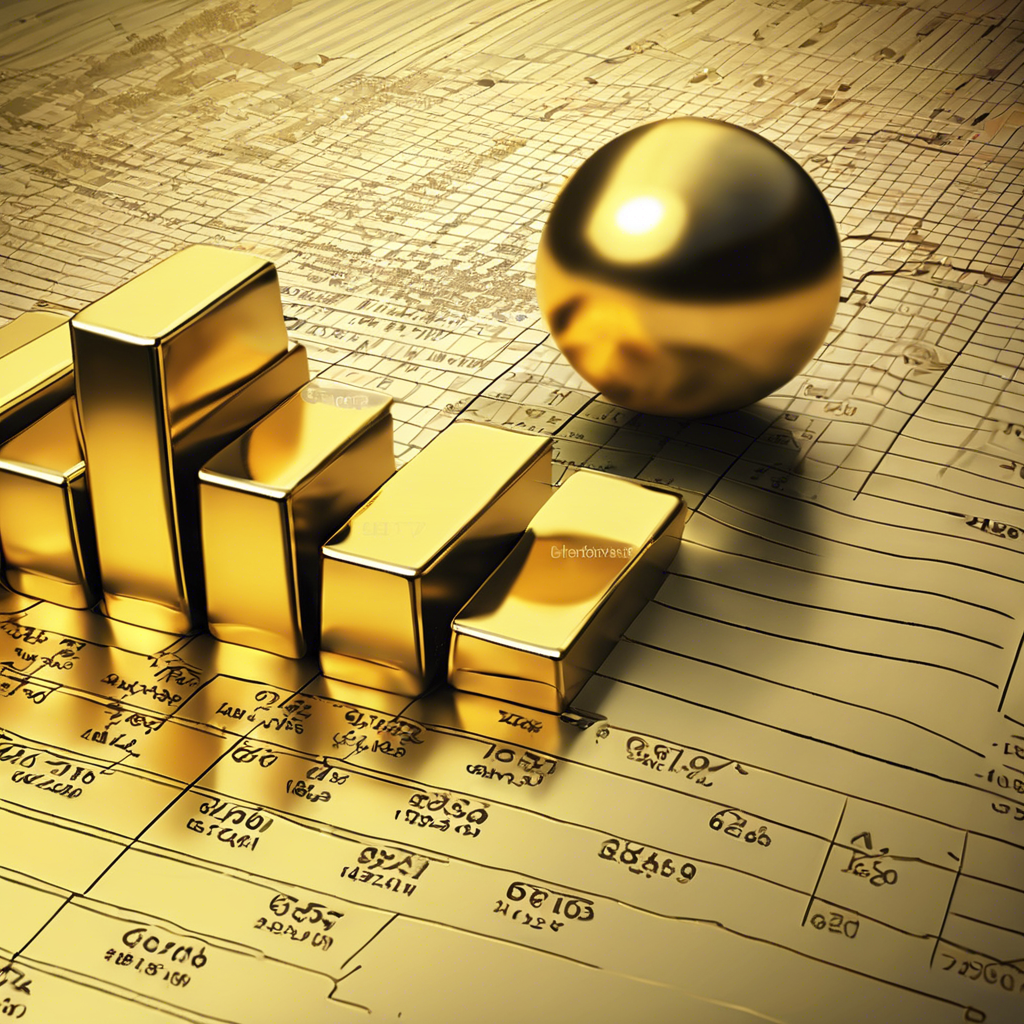Understanding Gold Price Trends: A Historical Perspective
Gold has long been recognized as a safe haven asset and a store of value, attracting investors globally. The fluctuations in gold prices can be attributed to various factors, including economic conditions, geopolitical tensions, and changes in supply and demand dynamics. Analyzing gold price trends through historical data provides valuable insights for investors looking to make informed decisions about their portfolios.
Historically, gold prices have shown a tendency to rise during periods of economic uncertainty. For instance, the financial crises of 2008 pushed gold prices to unprecedented levels as investors sought refuge from collapsing stock markets. This trend is consistent with the behavior of gold as a hedge against inflation and currency devaluation, making it a critical component in a diversified investment strategy.
The Impact of Economic Indicators on Gold Prices
Several economic indicators significantly influence gold price trends. Key among them are inflation rates, interest rates, and currency strength. When inflation rises and interest rates are low, gold prices tend to increase as the opportunity cost of holding gold decreases. Additionally, a weaker U.S. dollar often leads to higher gold prices, as gold becomes cheaper for investors holding other currencies.
Moreover, geopolitical events can trigger volatility in gold prices. For example, tensions in the Middle East or trade disputes can lead to increased demand for gold as a safe haven asset. Investors closely monitor global events, and their reactions can create short-term spikes in gold prices. Understanding these dynamics is crucial for anyone looking to invest in gold and capitalize on market movements.
Future Outlook: What to Expect in the Coming Years
Looking ahead, the future of gold prices will likely continue to be influenced by the same economic and geopolitical factors. With predictions of continued inflation and potential economic slowdowns, many analysts suggest that gold will retain its allure as a safe investment. For example, the gold price forecast for 2025 indicates a potential upward trend as investors seek to protect their wealth.
Additionally, the growing importance of gold in a diversified portfolio cannot be overlooked. As markets evolve, understanding how gold fits into investment strategies can help investors navigate the complexities of the financial landscape. By staying informed about gold price trends and the factors that drive them, investors can make strategic decisions that enhance their financial resilience.
Analyzing Current Gold Market Trends: Key Factors to Consider
The gold market is influenced by a myriad of factors that shape its pricing dynamics. Understanding these factors is essential for investors aiming to navigate the complexities of the gold landscape. Currently, we observe heightened interest in gold due to increasing inflation rates and geopolitical uncertainties. This trend reinforces the notion that gold remains a reliable hedge against financial instability.
The Role of Central Banks in Gold Demand
Central banks play a pivotal role in shaping gold demand. Their purchasing decisions can significantly impact market prices. In recent years, many central banks have increased their gold reserves, signaling confidence in gold as a strategic asset. This trend contributes to the overall perception of gold as a safe haven, particularly during economic downturns. Investors should keep a close eye on central bank activities, as they can provide essential insights into future price movements. For instance, understanding how central bank purchases affect the gold market can help investors make more informed decisions.
The Impact of Global Economic Conditions
Global economic conditions are another critical factor influencing gold prices. Economic slowdowns, trade tensions, and fluctuating currencies create an environment where gold is often seen as a safe bet. In recent times, the uncertainty surrounding economic recovery post-pandemic has led to increased gold buying. Investors are advised to consider the impacts of economic shifts on future gold prices when strategizing their investment approaches. The interplay between gold and economic indicators such as GDP growth and unemployment rates can also yield insights into potential price movements.
Investing Strategies: Best Practices for Gold Investment
When investing in gold, understanding effective strategies is crucial for maximizing returns. There are various ways to invest in gold, including physical gold, gold ETFs, and gold mining stocks. Each option comes with its own set of risks and rewards, making it essential for investors to choose wisely. A comprehensive overview of gold investment strategies can help in identifying the best approach based on individual financial goals and risk tolerance.
Physical Gold vs. Gold ETFs: Which is Better?
The debate between investing in physical gold versus gold ETFs continues to be a hot topic among investors. Physical gold, such as coins and bars, offers tangible value and the security of ownership. However, it also involves costs related to storage and insurance. On the other hand, gold ETFs provide liquidity and ease of trading but may lack the intrinsic value associated with physical gold. Evaluating physical gold vs. gold ETFs can help investors determine which investment aligns best with their portfolio strategy.
Maximizing Returns with Gold Trading Techniques
To enhance investment returns, employing effective gold trading techniques is vital. Understanding market trends, employing technical analysis, and being aware of global news that may affect gold prices can empower investors to make timely decisions. Moreover, exploring effective gold trading techniques can provide a competitive edge in the market. By developing a robust trading strategy, investors can better navigate fluctuations and optimize their investment outcomes.
Understanding Gold Investment Opportunities in 2025
As we look toward 2025, the landscape of gold investment presents numerous opportunities shaped by evolving market dynamics. Investors are increasingly recognizing the significance of gold as a hedge against inflation and economic uncertainty. With the potential for fluctuating prices, understanding the gold price forecast becomes paramount for strategic investment decisions.
The Importance of Diversification in Gold Investments
Diversifying your gold investments can significantly enhance your portfolio’s resilience. Whether it involves a mix of physical gold, ETFs, or gold mining stocks, each option contributes uniquely to risk management. Exploring gold investment strategies can provide insights into how to allocate assets effectively across various gold forms, ensuring that investors can capitalize on market movements while minimizing potential losses.
Spotlight on Gold Mining Stocks
Gold mining stocks present an attractive avenue for investors looking to profit from the gold market’s potential. These stocks can offer leveraged exposure to gold prices, meaning that as gold prices rise, mining companies’ profits can increase substantially. However, investing in gold mining stocks comes with inherent risks, including operational challenges and geopolitical factors that can affect production costs. It is crucial to perform thorough research and understand the specific companies involved before making investment commitments.
Current Trends Driving Gold Demand in 2025
The demand for gold is influenced by various factors, including economic conditions, technological advancements, and consumer behavior. In 2025, we expect to see shifts in demand driven by increased interest in gold as a digital asset and its use in sustainable technologies. Understanding current trends driving gold demand can provide investors with actionable insights into where to focus their investment strategies.
Geopolitical Influences on Gold Prices
Geopolitical tensions often result in increased gold buying as investors seek safe-haven assets. Events such as trade disputes, military conflicts, and changes in government policies can create uncertainty in financial markets, prompting investors to turn to gold. Keeping an eye on geopolitical events can help investors anticipate potential price movements and adjust their strategies accordingly.
Technological Innovations in Gold Trading
The advent of technology has transformed how investors trade gold. From online platforms that allow for real-time trading to advancements in blockchain, gold trading is more accessible than ever. Understanding effective gold trading techniques will empower investors to leverage these technological advancements to enhance their trading strategies.
Conclusion: Preparing for the Future of Gold Investments
In summary, the gold market is poised for significant changes in 2025, influenced by a combination of economic, geopolitical, and technological factors. By staying informed and adapting investment strategies accordingly, investors can position themselves to capitalize on the opportunities that lie ahead. Whether through traditional gold purchases or innovative trading methods, the key to success will be a well-rounded approach to gold investment.
Exploring Innovative Gold Investment Strategies
As we move deeper into 2025, investors are urged to explore innovative gold investment strategies that can adapt to the ever-changing market conditions. One notable trend is the rise of digital gold assets, which allow investors to hold gold in a more accessible format without the need for physical storage. This shift is particularly appealing to tech-savvy investors looking to incorporate gold into their portfolios via gold ETFs or digital platforms.
Understanding Gold ETFs and Their Appeal
Gold Exchange-Traded Funds (ETFs) are becoming increasingly popular among investors seeking to gain exposure to gold without the complexities of physical ownership. These funds track the price of gold and provide a convenient way to invest in gold through the stock market. By understanding how to navigate gold ETFs, investors can effectively leverage their benefits while managing risk.
The Role of Gold in a Diversified Portfolio
Incorporating gold into a diversified portfolio is essential for mitigating risks associated with market volatility. Gold often acts as a buffer during economic turbulence, making it an ideal asset for risk-averse investors. A well-structured investment strategy should include a mix of gold assets, such as physical gold, mining stocks, and ETFs, allowing investors to capitalize on the advantages of each type. For more insights on how to achieve this, consider exploring top gold investment strategies.
Evaluating Economic Indicators Impacting Gold Prices
To make informed decisions, investors need to stay attuned to economic indicators that influence gold prices. Metrics such as inflation rates, interest rates, and central bank policies play a crucial role in determining the attractiveness of gold as an investment. For instance, rising inflation typically leads investors to seek safe-haven assets like gold. Understanding how these factors interact can provide valuable insights for predicting gold price movements.
Impact of Central Bank Policies on Gold Investment
Central banks worldwide play a pivotal role in the gold market by managing their gold reserves and influencing monetary policy. When central banks increase their gold purchases, it often signals confidence in gold as a long-term asset and can lead to price increases. Keeping an eye on central bank activities can provide investors with valuable context for their investment strategies.
Conclusion: Preparing for a Dynamic Gold Investment Landscape
As gold investment strategies evolve, staying informed about market trends, technological advancements, and economic indicators will be crucial for investors. By adopting a diversified approach and leveraging innovative investment opportunities, individuals can maximize their potential returns in the dynamic landscape of gold investments. Remember, whether you are a seasoned investor or a beginner, establishing a solid foundation in gold investment will pave the way for long-term success in 2025 and beyond.
Frequently Asked Questions about Gold Investment
What are the main benefits of investing in gold?
Investing in gold offers several advantages, including portfolio diversification, protection against inflation, and a hedge during economic downturns. Gold is often viewed as a safe-haven asset, providing stability when other markets are volatile.
How do I start investing in gold?
To start investing in gold, you can consider various options such as purchasing physical gold (e.g., coins or bars), investing in gold ETFs, or exploring gold mining stocks. Each option has its own benefits and risks, so it’s essential to research and choose the one that aligns with your investment strategy.
Are gold ETFs a good investment?
Gold ETFs can be a good investment for those looking to gain exposure to gold without the need to store physical assets. They provide liquidity and can be traded like stocks, making them an attractive option for many investors. However, it’s crucial to understand the specific ETF’s structure and fees.
How does inflation impact gold prices?
Inflation typically leads to an increase in gold prices. As the cost of living rises, investors often turn to gold as a hedge against the diminishing purchasing power of currency. This heightened demand can drive up gold prices significantly.
What factors should I consider when choosing gold investments?
When choosing gold investments, consider factors such as your investment goals, risk tolerance, market conditions, and the specific characteristics of the gold asset you are considering. It’s also beneficial to stay updated on economic indicators and central bank policies that could influence gold prices.
Is it better to invest in physical gold or gold stocks?
Whether to invest in physical gold or gold stocks depends on your investment strategy. Physical gold provides tangible assets and is less affected by stock market fluctuations, while gold stocks can offer higher potential returns through company performance but come with increased risk. Diversifying between both can balance the benefits.
How can I track gold prices?
You can track gold prices using financial news websites, investment apps, or market platforms that provide real-time data. Many financial news outlets also offer insights and analysis on gold market trends.
What are the risks associated with investing in gold?
Investing in gold comes with risks, including price volatility, storage costs for physical gold, and potential regulatory changes affecting gold markets. It’s essential to assess these risks and consider them in your overall investment strategy.
Can I invest in gold through my retirement account?
Yes, you can invest in gold through certain retirement accounts, such as a self-directed IRA. This allows you to hold physical gold and other precious metals as part of your retirement portfolio. Be sure to research the specific rules and regulations governing such investments.
Authority Resources for Gold Investment
For those looking to deepen their understanding of gold investment, several trusted resources provide valuable insights:
- Investopedia – Gold Investment Overview: A comprehensive guide to understanding gold as an investment.
- Kitco Metals – Gold Market News: Provides up-to-date news and analysis on gold prices and market trends.
- World Gold Council: A global authority on gold, offering research and statistics on gold investment and market dynamics.
- Federal Reserve: Offers insights into monetary policy decisions that can impact gold prices.
- Mining.com: A resource for news and analysis related to gold mining stocks and industry developments.
Conclusion: Embracing the Future of Gold Investment
The landscape of gold investment is continuously evolving, and by exploring innovative strategies and staying informed on economic indicators, investors can maximize their potential returns. Whether you’re considering gold ETFs, physical gold, or mining stocks, a diversified approach is key to navigating this dynamic market. As we progress through 2025, remember that establishing a solid foundation in gold investment will not only safeguard your assets but also enhance your portfolio’s resilience against economic uncertainties.











This comprehensive overview of gold price trends really highlights how crucial it is for investors to stay informed about various economic indicators and geopolitical events that influence gold. I’ve personally found that monitoring central bank activities and inflation data has helped me make more timely decisions regarding gold investments. The post’s emphasis on diversifying into physical gold, ETFs, and mining stocks is particularly relevant, as each asset class offers unique advantages and risks, making diversification key in managing overall portfolio risk. One aspect I’d love to explore further is how technological advancements, especially blockchain and digital gold platforms, will shape future investing in gold. Do others see these innovations as a game-changer for retail investors or just a trend? It seems like leveraging technology could make gold investing more accessible and transparent, but I wonder about any potential risks or drawbacks that come with these new methods.